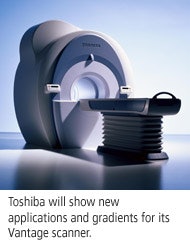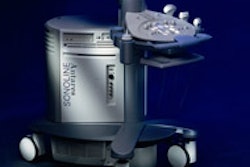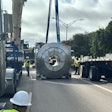Toshiba will highlight new enhancements and applications for Vantage, the Tustin, CA, vendor's ultra-short-bore 1.5-tesla scanner. The company will also demonstrate breast imaging techniques on its Ultra 0.35-tesla superconducting open scanner, and will roll out a new computer platform and hardware upgrade for its Opart scanners.

Vantage has a 1.4-m magnet length and 65.5-cm aperture that is well-suited for claustrophobic patients. The system has helped Toshiba capture market share in the 1.5-tesla segment, according to the company.
Toshiba plans to discuss recent research using Vantage for diffusion-weighted imaging (DWI), which produces PET-like images in which malignant tissue lights up next to normal tissue. Toshiba will show images of the technique for whole-body applications -- a departure from the traditional applications of DWI for brain imaging.
Dual-uniform overlay (DUO) is a technique for imaging the torso that simultaneously uses two of Toshiba's SPEEDER parallel-imaging coils. Toshiba considers the DUO superior to other techniques that use simultaneous coils because it employs high-resolution coils rather than linear coils, enabling users to image a region of interest at high resolution. DUO could be used for screening applications of the torso, from the chin to the hips.
The company will also demonstrate a new gradient package for Vantage that comes in multiple configurations. At the high end, the ZGV package boasts a slew rate of 200 T/m/s and an amplitude of 33 mT/m; the XGV package a slew rate of 130 T/m/s and an amplitude of 30 mTm; MGV has a slew rate of 86 T/m/s and an amplitude of 30 mTm; while the AGV has a slew rate of 50 T/m/s and an amplitude of 30 mT/m. Users can upgrade from lower-tier gradient packages to the top of the line, according to the company.
Toshiba will focus on a new breast imaging package for its Ultra 0.35-tesla superconducting open magnet that enables users to conduct biopsy techniques without having to reposition the patient. A fluoro MRI technique can visualize the biopsy needle as it moves into the target lesion, ensuring more accurate breast biopsies.
For the older Opart open superconducting systems, Toshiba is introducing a new computer and upgrade platform that will include 20 new sequences not available previously, such as steady-state free-precession imaging.
The upgrade includes a new computer workstation, an Octane2 computer from SGI of Mountain View, CA, that gives Opart up to 14 times the processing speed for computationally intensive tasks like 3D reconstructions. In addition, Version 5 software includes upgrades for past software packages purchased for Opart systems, according to the company.
By Brian Casey
AuntMinnie.com staff writer
November 15, 2004
Copyright © 2004 AuntMinnie.com


.fFmgij6Hin.png?auto=compress%2Cformat&fit=crop&h=100&q=70&w=100)





.fFmgij6Hin.png?auto=compress%2Cformat&fit=crop&h=167&q=70&w=250)











